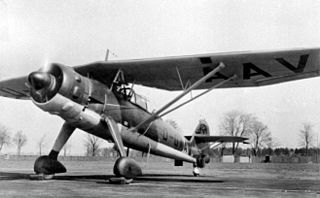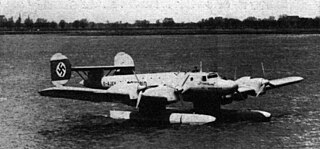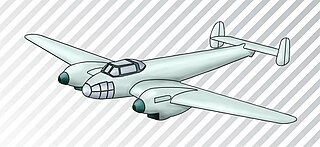
The Henschel Hs 129 was a World War II ground-attack aircraft fielded by the German Luftwaffe. The aircraft saw combat in Tunisia and on the Eastern Front.

The Messerschmitt Me 264 was a long-range strategic bomber developed during World War II for the German Luftwaffe as its main strategic bomber. The design was later selected as Messerschmitt's competitor in the Reichsluftfahrtministerium's Amerikabomber programme, for a strategic bomber capable of attacking New York City from bases in France or the Azores.

Henschel's Hs 132 was a World War II dive bomber and interceptor aircraft of the German Luftwaffe that never saw service. The unorthodox design featured a top-mounted BMW 003 jet engine and the pilot in a prone position. The Soviet Army occupied the factory just as the Hs 132 V1 was nearing flight testing, the V2 and V3 being 80% and 75% completed.

The Blohm & Voss BV 238 was a German flying boat, built during World War II. It was the heaviest aircraft ever built when it first flew in 1944, and was the largest aircraft produced by any of the Axis powers during World War II.

The Henschel Hs 126 was a German two-seat reconnaissance and observation aircraft of World War II that was derived from the Henschel Hs 122. The pilot was seated in a protected cockpit under the parasol wing and the gunner in an open rear cockpit. The prototype aircraft frame was that of a Hs 122A fitted with a Junkers engine. The Hs 126 was well received for its good short takeoff and low-speed characteristics which were needed at the time. It was put into service for a few years, but was soon superseded by the general-purpose, STOL Fieseler Fi 156 Storch and the medium-range Focke-Wulf Fw 189 "flying eye".

The Blohm & Voss Ha 139 was a German all-metal inverted gull wing floatplane. With its four engines it was at the time one of the largest float-equipped seaplanes that had been built. The inboard engines were mounted at the joint between the inboard anhedral and outboard dihedral wing sections, above the pylon-mounted floats.
The Henschel Hs 127 was a German bomber that was built as two prototypes, but cancelled without entering mass production.

The Hamburger Flugzeugbau Ha 137 was a German ground-attack aircraft of the 1930s. It was Blohm & Voss' entry into the contest to equip the re-forming Luftwaffe with its first purpose-built dive bomber. Although the contest would eventually be won by the Junkers Ju 87, the Ha 137 demonstrated that B&V's Hamburger Flugzeugbau, not even two years old at this point, had a truly capable design team of its own. One Ha 137 single-seat prototype competed against the Henschel Hs 123 at Rechlin.

The Messerschmitt Bf 162 was a light bomber aircraft designed in Germany prior to World War II, which flew only in prototype form.

The Heinkel He 118 was a prototype German monoplane dive bomber design that lost out to the Junkers Ju 87 Stuka in the 1930s, and was never ordered by the Luftwaffe.

The Focke-Wulf Fw 57 was a prototype German heavy fighter and fighter-bomber. Prototypes were built in 1936 but never entered production.

The Blohm & Voss Ha 142 was a German four-engined long-distance monoplane, developed to meet a Luft Hansa requirement for its transatlantic airmail service. The first of several prototypes flew on 11 October 1938 and they saw some service in other roles during the Second World War.

The Heinkel He 45 was a light bomber produced in Germany in the early 1930s, one of the first aircraft adopted by the newly formed Luftwaffe. Its appearance was that of a conventional biplane and included seating for pilot and gunner in tandem, open cockpits. Developed in parallel with the He 46, it appeared in 1931 as a general-purpose biplane and was employed mainly as a trainer, but was also used by the Luftwaffe for reconnaissance and light bombing duties. Production of this plane totalled 512 aircraft, including those built under licence by Gotha, Focke-Wulf, and BFW.

The Henschel Hs 130 was a German high-altitude reconnaissance and bomber aircraft developed in World War II. It suffered from various mechanical faults and was never used operationally, only existing as prototype airframes.
The Dornier Do 317 was a prototype German medium bomber of World War II.

The Henschel Hs 124 was a twin-engine heavy fighter, attack aircraft and light bomber designed in Nazi Germany. After two prototypes had been built, work on the project was cancelled.

The Fieseler Fi 98 was a prototype ground-attack aircraft produced by German aircraft manufacturer Fieseler as a rival to the Henschel Hs 123.

The Arado Ar 76 was a German aircraft of the 1930s, designed as a light fighter with a secondary role as an advanced trainer in mind.

The Henschel Hs 122 was a German army cooperation/reconnaissance aircraft of the mid-1930s, radial-engined and with a parasol wing. Though only pre-production variants entered service, the Hs 122 led on to the Hs 126 which was produced in large numbers.

The Arado Ar 198 was a prototype reconnaissance aircraft, developed by Arado Flugzeugwerke, with backing from the Luftwaffe, who initially preferred it over the Blohm & Voss BV 141 and the Focke-Wulf Fw 189. However, when flight tests were carried out the aircraft performed poorly, and did not impress the Luftwaffe. One aircraft was completed in 1938.



















